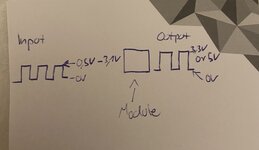gs1
Newbie
Hello,
I want to boost a PWM Signal thats less than 3,3V to 3,3V or 5V. I want to be able to decide with a switch whether I have 3,3 or 5V at the output. In addition, an LED should be lit if there is a signal at the entrance. The LED should not draw the energy from the signal.
I've attached a circuit how it might work. I would realize the 9V via a battery. I haven't calculated the values of the resistors yet.
Do you think this design will work? Or do you have a suggestion for a smarter design?
Unfortunately, I can't insert the circuit as a picture. That's why the link:
https://www.falstad.com/circuit/cir...Dq5MMeNByQeNPbwR3IRWAO4EC1l3ZBxAfc-HwG4eWfdAA

I really hope someone can help me. Thanks in advance
I want to boost a PWM Signal thats less than 3,3V to 3,3V or 5V. I want to be able to decide with a switch whether I have 3,3 or 5V at the output. In addition, an LED should be lit if there is a signal at the entrance. The LED should not draw the energy from the signal.
I've attached a circuit how it might work. I would realize the 9V via a battery. I haven't calculated the values of the resistors yet.
Do you think this design will work? Or do you have a suggestion for a smarter design?
Unfortunately, I can't insert the circuit as a picture. That's why the link:
https://www.falstad.com/circuit/cir...Dq5MMeNByQeNPbwR3IRWAO4EC1l3ZBxAfc-HwG4eWfdAA
I really hope someone can help me. Thanks in advance
Last edited by a moderator:
